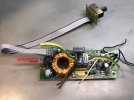I've recent debate on whether to convert one of these LGB locomotive to have DCC and sound.
And I'm curious to know if anyone has used one of these Massoth decoders in the loco.
Massoth XLS-Onboard Sound Decoder.

Is this a good decoder to use?
I like the fact that all I need to do is use the existing plugs of the Motors, and the 4 position on/off switch.
Usually I always do my research before asking silly question, but I'm stumped on a few things.
Most of the plugs I can understand what they do.
But I'm not sure where the following will go on the board
- The Smoke unit. (Is it possible to keep the original 5 volt unit?)
- Multi-purpose socket (the old round terminals on the back of the bunker)
- Fire box flicker. (I would like to add a fireglow if possible)
I'm not fully keen on installing a reed switch for the chuff.
What CVs do I need to program to make the sound be affected by voltage steps and not hall sensor?
And I'm curious to know if anyone has used one of these Massoth decoders in the loco.
Massoth XLS-Onboard Sound Decoder.

Is this a good decoder to use?
I like the fact that all I need to do is use the existing plugs of the Motors, and the 4 position on/off switch.
Usually I always do my research before asking silly question, but I'm stumped on a few things.
Most of the plugs I can understand what they do.
But I'm not sure where the following will go on the board
- The Smoke unit. (Is it possible to keep the original 5 volt unit?)
- Multi-purpose socket (the old round terminals on the back of the bunker)
- Fire box flicker. (I would like to add a fireglow if possible)
I'm not fully keen on installing a reed switch for the chuff.
What CVs do I need to program to make the sound be affected by voltage steps and not hall sensor?
Last edited:


